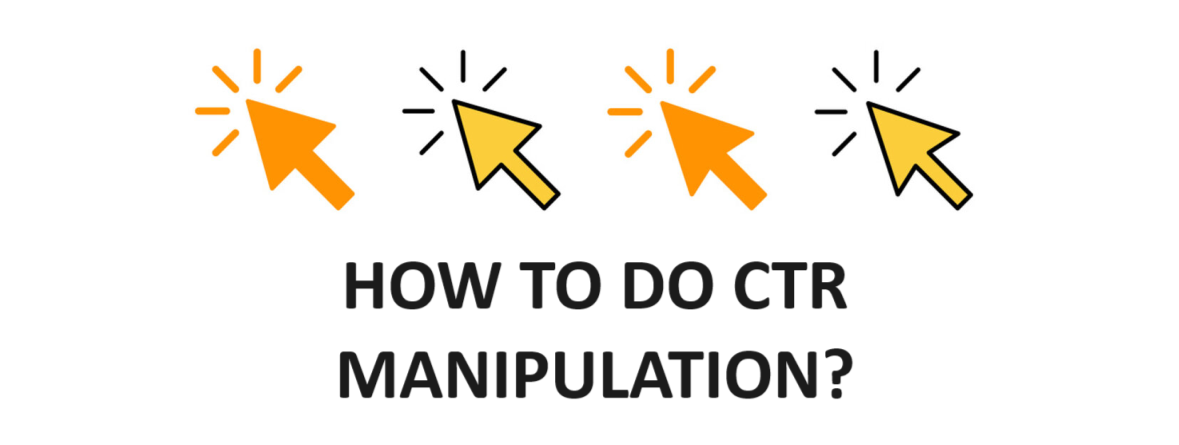Exploring the Relationship In Between CTR Control Providers and Customer Actions
In the realm of digital advertising and marketing, the influence of click-through rate (CTR) control solutions on user actions stays a complex and intriguing topic. As online platforms progressively rely upon CTR metrics to determine the success of content, products, and services, understanding just how these controlled rates effect individual engagement and decision-making procedures is paramount. The interplay in between CTR manipulation and individual actions increases inquiries regarding credibility, dependability, and the moral implications of such methods. By exploring the elaborate relationship between CTR adjustment solutions and user habits, interesting insights emerge that might improve our understanding of electronic advertising and marketing methods and their impacts on customers.
Impact of CTR Control on Habits
Examining the impact of Click-Through Rate (CTR) manipulation on user actions exposes vital insights right into the dynamics of online interaction. CTR adjustment involves artificially pumping up the variety of clicks on a particular web link or advertisement to trick individuals and online search engine. This method can bring about an altered perception of a webpage's popularity or importance, inevitably influencing individual behavior.

Additionally, CTR adjustment can alter the data utilized by formulas to personalize individual experiences. This can lead to individuals being offered content that does not line up with their choices or passions, eventually bring about a decline in user satisfaction and involvement. Recognizing the effect of CTR control on user actions is important for keeping transparency and trust in on-line communications.
Customer Involvement With Manipulated CTR
Individual engagement with manipulated CTR data frequently results in manipulated assumptions of on the internet content appeal and significance. When users engage with web content based on unnaturally filled with air Click-Through Rates (CTR), they might think that specific info, items, or services are more popular or trustworthy than they in fact are. This can cause customers making decisions based on misleading information, causing potentially undesirable outcomes.
Involvement metrics like sort, shares, remarks, and time spent on a web page are commonly affected by CTR manipulation. Individuals might be extra inclined to involve with web content that shows up to have higher involvement prices, additionally continuing the cycle of manipulated perceptions. As an outcome, content makers and advertisers might prioritize generating material that produces high CTR as opposed to concentrating on creating truly important and relevant product.

Psychological Results of CTR Control

In addition, the mental results of CTR adjustment can likewise show up in modified decision-making procedures. Individuals may be a lot more likely to click material entirely based on its perceived popularity, instead of its actual value or importance to their demands. This behavioral change can lead to a superficial involvement with online web content, where users might neglect top quality yet less popular offerings for those with unnaturally increased CTRs.
Basically, the mental implications of CTR control highlight the importance of preserving openness and authenticity in on-line interactions to promote genuine customer engagement and count on.
Moral Considerations in CTR Control
CTR adjustment raises problems regarding deceiving customers, distorting data analytics, and endangering the credibility of online content. By unnaturally inflating CTR, customers may be misled into clicking on web links or ads they would not have picked otherwise, leading to an insincere online experience.
An additional moral element to contemplate is the justness of adjusting CTR to get an unjust advantage over competitors. Participating in such practices not just breaches principles of reasonable play yet likewise undermines the trust that users place in on the internet platforms. It is important for businesses and electronic marketing professionals to support ethical criteria in their methods to ensure openness, trustworthiness, and long-term sustainability in the on-line atmosphere.
Implications for Digital Advertising And Marketing
With the enhancing dependence on electronic platforms for advertising and marketing functions, the technique of controling click-through prices (CTR) presents significant effects for the efficiency and honesty of digital advertising and marketing techniques. CTR adjustment can lead to skewed information analytics, misdirecting marketers into thinking that their campaigns are doing far better than they in fact are. This can result in misallocation GMB CTR manipulation of resources, with business investing in underperforming methods based on falsified CTRs. When individuals recognize that CTRs have actually been adjusted, it can erode count on in the brand, leading to long-lasting adverse repercussions for client commitment and brand name online reputation.
In addition, making use of CTR manipulation services can develop an unreasonable competitive landscape, where companies that participate in such techniques obtain a man-made advantage over those that follow honest advertising and marketing standards. This can suppress innovation and imagination in digital advertising, as success comes to be more concerning control techniques than supplying authentic value to consumers. Ultimately, the ramifications of CTR control for digital advertising and marketing extend past short-term gains, influencing the general sustainability and credibility of marketing efforts in the electronic world.
Final Thought
Finally, the partnership in between CTR adjustment solutions and individual habits is intricate and diverse. The influence of CTR manipulation on habits, user involvement with controlled CTR, emotional results, honest factors to consider, and effects for digital advertising all play a function fit this partnership. Understanding these dynamics is essential for marketing professionals and researchers alike in order to navigate the ethical ramifications and make the most of the performance of their digital advertising strategies.